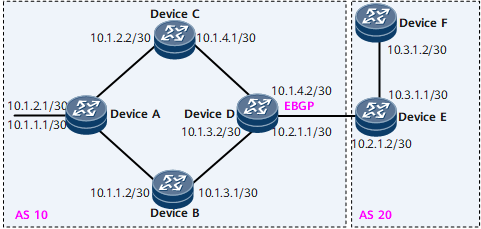OSPF-BGP Synchronization
Background
When a new device is deployed on a network or a device is restarted, network traffic may be lost during BGP route convergence because IGP routes converge more quickly than BGP routes.
OSPF-BGP synchronization can address this problem.
Purpose
If a backup link exists, BGP traffic may be lost during traffic switchback because BGP routes converge more slowly than OSPF routes do.
In Figure 1, Device A, Device B, Device C, and Device D run OSPF and establish IBGP connections. Device C functions as the backup of Device B. When the network is stable, BGP and OSPF routes converge completely on the router.
In most cases, traffic from Device A to 10.3.1.0/30 passes through Device B. If Device B fails, traffic is switched to Device C. After Device B recovers, traffic is switched back to Device B. During this process, packet loss occurs.
Consequently, convergence of OSPF routes is complete whereas BGP route convergence is still going on. As a result, Device B does not have the route to 10.3.1.0/30.
When packets from Device A to 10.3.1.0/30 reach Device B, Device B discards them because Device B does not have the route to 10.3.1.0/30.
Principles
If OSPF-BGP synchronization is configured on a device, the device remains as a stub router during the set synchronization period. During this period, the link metric in the LSA advertised by the device is set to the maximum value (65535), instructing other OSPF routers not to use it as a transit router for data forwarding.
In Figure 1, OSPF-BGP synchronization is enabled on Router B. In this situation, before BGP route convergence is complete, Device A keeps forwarding data through Device C rather than Device B until BGP route convergence on Device B is complete.
